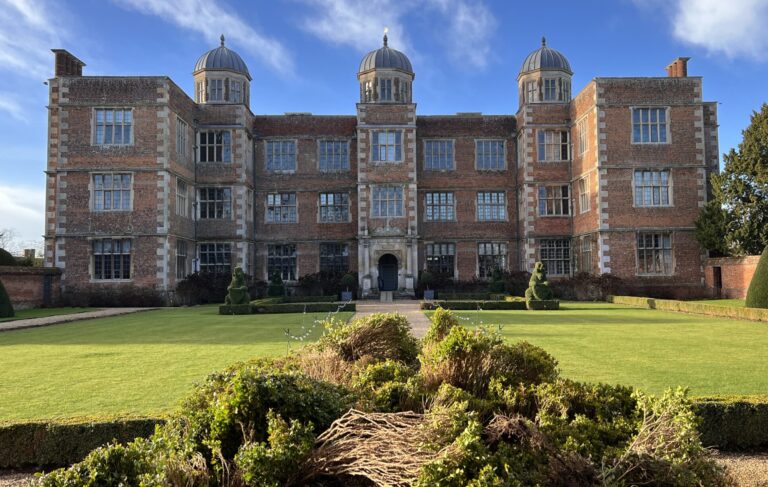The Garden Team started the new year with a big project in the East Front, working hard to renovate and restore the formal box hedge. This project has been 2 and a half years in the making, read on to find out why in our Head Gardener’s blog.
The box hedge (Buxus sempervirens) in the East Front is a true garden classic, a popular architectural evergreen that provides much-needed structure and symmetry. For several years we had noticed that the box was struggling and halfway through 2020 we started work on a rejuvenation process. We sent several specimens to get tested to understand what we were dealing with, the results came back that the box had three types of fungus and the main concern was Volutella blight, also called Volutella canker. Due to these findings, we embarked on a treatment plan and strong feeding programme to attempt to slow down the Volutella blight with the hope of restoring the box to how it should look. We also tried removing the outside hedging and transplanting good specimens into gaps and replacing tired-looking plants. We took great care to give the transplants the best chance of survival but, most probably due to the great stress they were under, they unfortunately didn’t take.
Sadly, over time all the plants would have succumbed to Volutella blight, showing discolouration and dying. Whilst researching, we found that it wasn’t recommended that we replant the Buxus in the same place due to the pathogens within the soil that we had removed the Buxus hedge from and we couldn’t guarantee the Buxus that was bought in was free of boxwood blight (Calonectria pseudonaviculata and Calonectria henricotiae). To prevent this, we would need to isolate these plants away from any other Buxus and keep monitoring them to guarantee that they were free from blight.
After consultation with the RHS and other historic houses, we made the difficult decision to remove and restore the hedge with Euonymus Green Spire and Jean Hugues. We planted around 1000 plants, using bonemeal, mycorrhizal fungi as a feed and plant aid, slow-release fertiliser within the plant pots themselves and also bedded in with locally-sourced compost. Green Spire and Jean Hugues have beautiful glossy green leaves – Jean Hugues is a bush type whereas Green Spire has a tall appearance. Once cut this does go bushy, but we knew with these plants we were going to get an instant hedge impact, and we did.
Seeing this project from start to finish has been incredibly exciting, but also it has had some stressful and tricky moments along the way. We had to order enough plants, make sure that they took and also hit a deadline to get the East Front ready in time for the first wedding of the season. When we started the removal and planting, we came across many tricky moments. When running the long trenches along the grass, we discovered the Elizabethan path. Unlike today, the original paths were different. The central path is the original but there was also a circular path within the East Front. When it took 1 hour to go through 3 meters of trench, we knew we were in for a long day and the closer we got to the Hall the harder the digging was. We then started coming across the Victorian drainage system that we still use today for the rainwater off the Hall and we also came across an old Elizabethan drain that seemed to run in the direction of the Kitchen Garden pond.
When we got to the unicorn topiaries, it felt like we went from Gardeners to Time Team, there were no spades used to dig out, we were using hand trowels and very narrow tree planting spades. We had to protect the unicorns at all costs as the root system of these beautiful topiaries seem to be surface rooting. So cautiously and slowly we removed the soil around them and proceeded to dig out ready for the Euonymus.
Over the next few months, it is incredibly important to let the plants bed in and get their roots established. When we start getting warmer weather, we will give them a cut to a rough height for the season and hopefully this will encourage them to put side shoots out and bush out. So over the next few months, the plants will be of differing heights until it’s time for their first haircut.
The care plan for the Euonymus is to install a watering system using a leaky hose. With the typical Lincolnshire weather, we don’t have enough rain and we’ve already had to set up water sprinklers as we haven’t had any rain since planting them. We will look at feeding them again in the summer with seaweed as they have had lots of beneficial food when planted.
We hope our visitors will enjoy our new glossy green dwarf hedging. It works beautifully with the clipped yew cones and our guardian unicorns.
A big thank you to the whole Garden Team for delivering this project on time and ready for the season ahead.
-Jordan Wallhead, Head Gardener
VISIT THE GARDENS
The Gardens reopen this Sunday 5 February for our spectacular Spring Bulb Pageant.
5 February – 29 March 2023. Gardens open Wednesdays & Sundays only, 10am-4pm, last entry 3pm.
Adult: £8.50, Child: £4.50, Family: £22
Tickets available on arrival at the Gatehouse.










